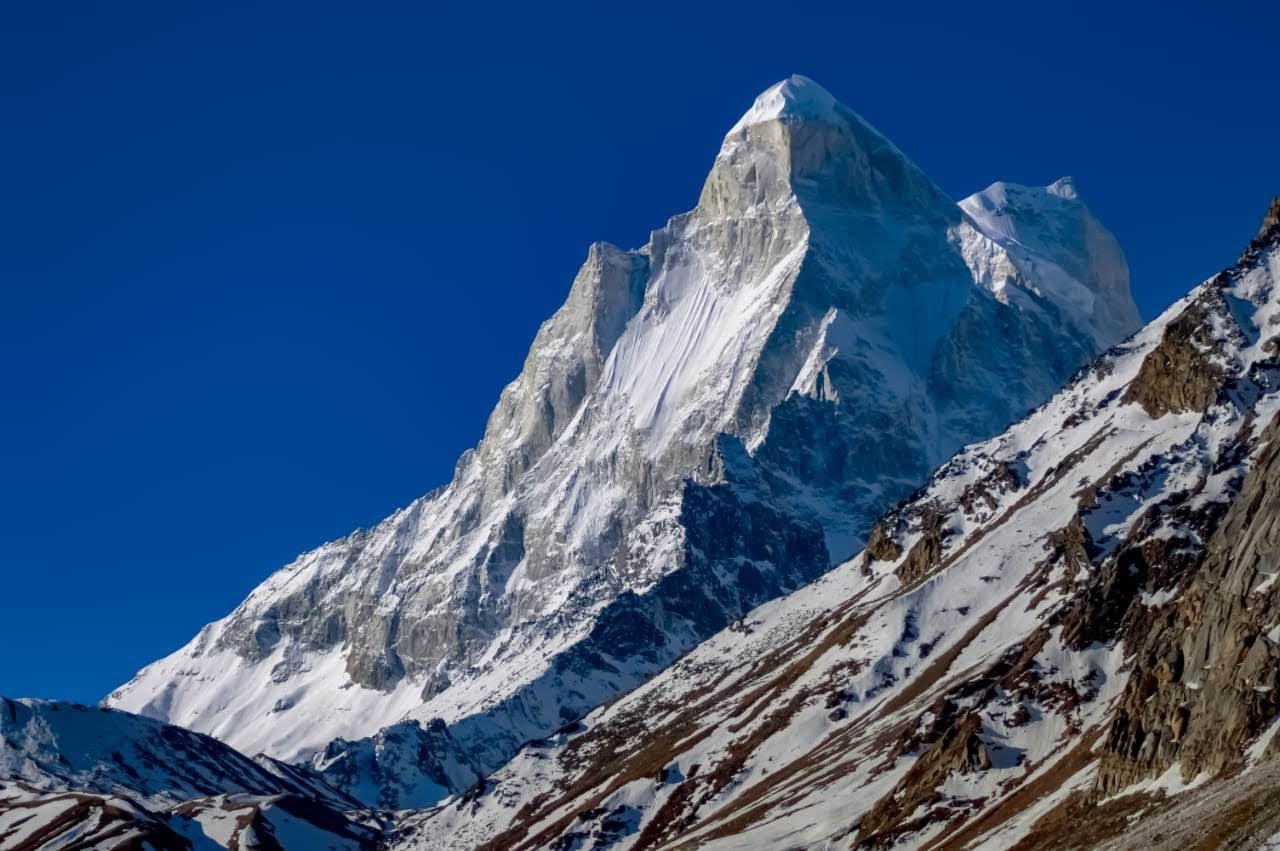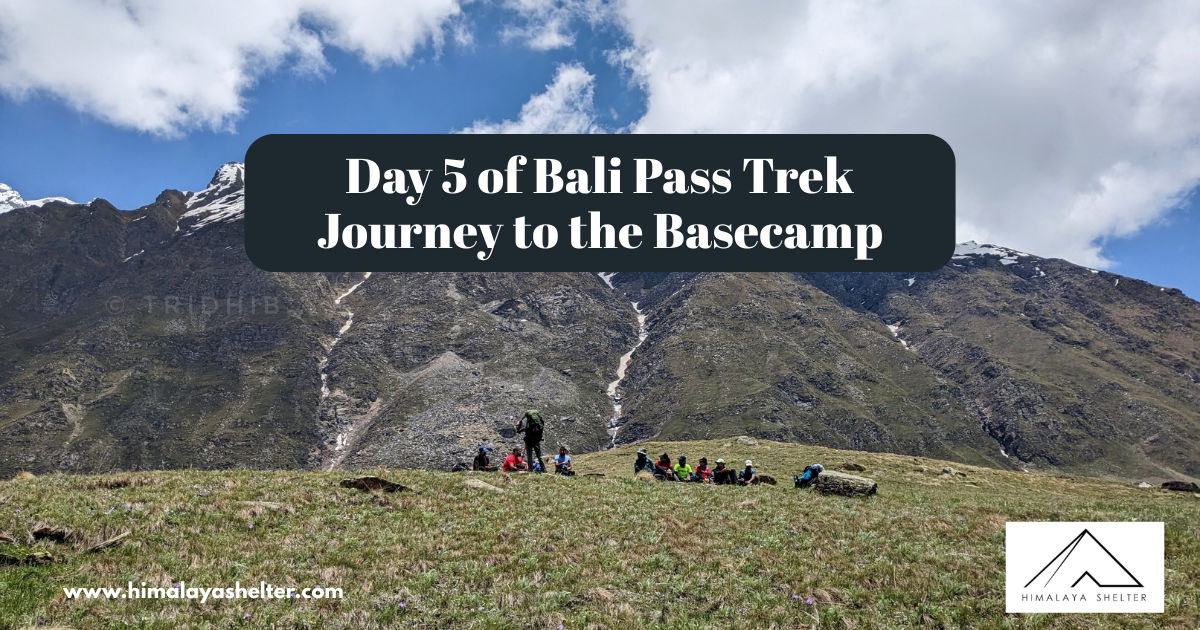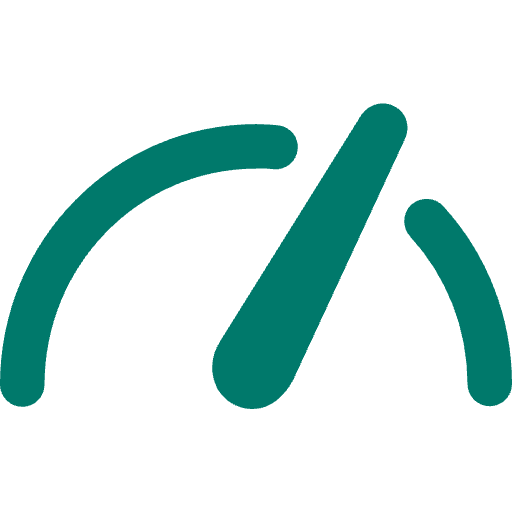
Bali Pass Trek
TREK DIFFICULTY
Difficult
TREK DURATION
9 Days
HIGHEST ALTITUDE
16,240 Feet
GROUP SIZE
12
TREK DISTANCE
66 Km
BASECAMP
Bali Pass Trek, Uttarakhand
BEST TIME
May to June | September to October
PICKUP POINT
Dehradun (Prince Chowk)
Bali Pass Trek Overview:
Bali Pass is a mountain pass that peaks slightly short of the 5000-meter mark and connects the Har Ki Dun - Ruinsara Valley to Yamunotri and vice-versa. The Bali Pass trek runs through numerous heritage Villages of Har Ki Dun Valley such as Osla, Gangaad, and Taluka, and ascends deep into the Govind National Park. On the route, we come across the beautiful Ruinsara Lake. Multiple Waterfalls lie on the way to the pass.
The Bali Pass trek distance is 66 KM from Taluka to Janki Chatti. The trek is on the difficult end as the Bali Pass trek altitude is more than 16000 feet and has long walking days, with steep ascents and descents. If one plans to attempt the Bali Pass trek solo, it is highly advised to trek along a route guide as it is easy to misjudge the trail while descending or ascending the pass, with steep sections that can cause mishaps.

How difficult is the Bali Pass trek?
Bali pass trek difficulty/ High altitude trek at At the height of altitude of 16,240 feet/4,950 meters. The Bali pass trek has a distance of 66 km, starting from Taluka to the endpoint at Janki Chatti. It takes 6 to 7 days to complete the trek on foot. Thus we will walk around 10 KM on average every day.
The altitude of Taluka, where the trek starts, is 6,825 feet (2080 meters). We thus have a net altitude gain of 9,250 feet (2,820 meters) over a duration of 5 days, thus climbing an average of 550 meters a day or 1800 feet. That is a considerable altitude gain. The distance, altitude gain, and finally the technical pass crossing make Bali Pass fall in the category of a Moderate-Difficult trek.
It requires physical preparation and regular exercises that must be started at least 1 month prior to trekking to the Bali Pass.
How to Plan Bali Pass trek?
The pass is more approachable from the Har Ki Dun Valley as the gradient is less steep and gives good time for the trekkers to acclimatize to the altitude. Although a few trekkers start the trek from Yamunotri too, which is not generally recommended. This is because the altitude gain from Yamunotri is very quick and the steep trail can quickly tire trekkers. It can even lead to acute mountain sickness as there is barely any acclimatization to the high altitude.
The route from Sankri has multiple campsites on the route and the itinerary can be easily changed for the convenience of trekkers. Generally, the pass is attempted from Thanga, situated at 4100 meters. However, we can push to camp further at the base camp at a whopping 4,600 meters of altitude. This reduces the strain for the pass crossing day and further gives a unique experience of camping at a very high altitude. The Swargarohini has astounding views from the Bali Pass basecamp.
Day 1: Drive from Dehradun to Sankri | Drive: 190 km; 8 hrs
Day 2: Trek from Sankri (1,920 m) to Seema (2,560 m) via Taluka (2,050 m) | Drive: 1 hr; Trek: 14 km; 5-6 hrs
Day 3: Trek from Seema (2,560 m) to Roiltia or Waterfall camp (3,350 m) | Trek 13 km; 6 hrs
Day 4: Waterfall to Ruinsara lake (3,600 m) | Trek: 4 km; 2 hrs
Day 5: Ruinsara lake - rest and explore or Trek to Thanga | Trek: 3 km; 1.5 hrs
Day 6: Ruinsara lake/Thanga to Bali Pass Basecamp (4,600 m) | Trek: 8 km; 7 hrs
Day 7: Bali Pass Basecamp (4,600 m) to Lower Dhamni (3,200 m) via Bali pass (4,900 m) | Trek: 12 km; 9 hrs
Day 8: Lower Dhamni to Yamunotri to Janki Chatti (2,400 m)| Trek: 12 km; 6 hrs
Day 9: Drive from Janki Chatti to Dehradun | Drive: 190 km; 8 hrs
In Himalaya Shelter, we provide you with the option to customize your trekking experience. Whether you're a solo traveler, a group of friends, or a family, you can opt for our personalized tailor-made trekking program. This customized trek will be exclusively designed for you, taking into account your specific requirements for transportation, accommodation, meals, and any other premium facilities you may need during the trek. No other participants will be added to your group. Choosing a customized trek will enable you to fully enjoy the trek with your loved ones. Click here to learn what a Customized Trekking program looks like.
The Bali Pass trek route map shows you the way across the stunning Garhwal Himalayas. It takes you past the charming Devsu Bugyal and Ruinsara Lake to reach the stunning Bali Pass at an impressive altitude of 16,200 ft. Following the scenic route along the Supin River, the map points out the awe-inspiring sights of snow-capped peaks and lush meadows. It promises an exciting adventure for both trekkers and nature lovers.
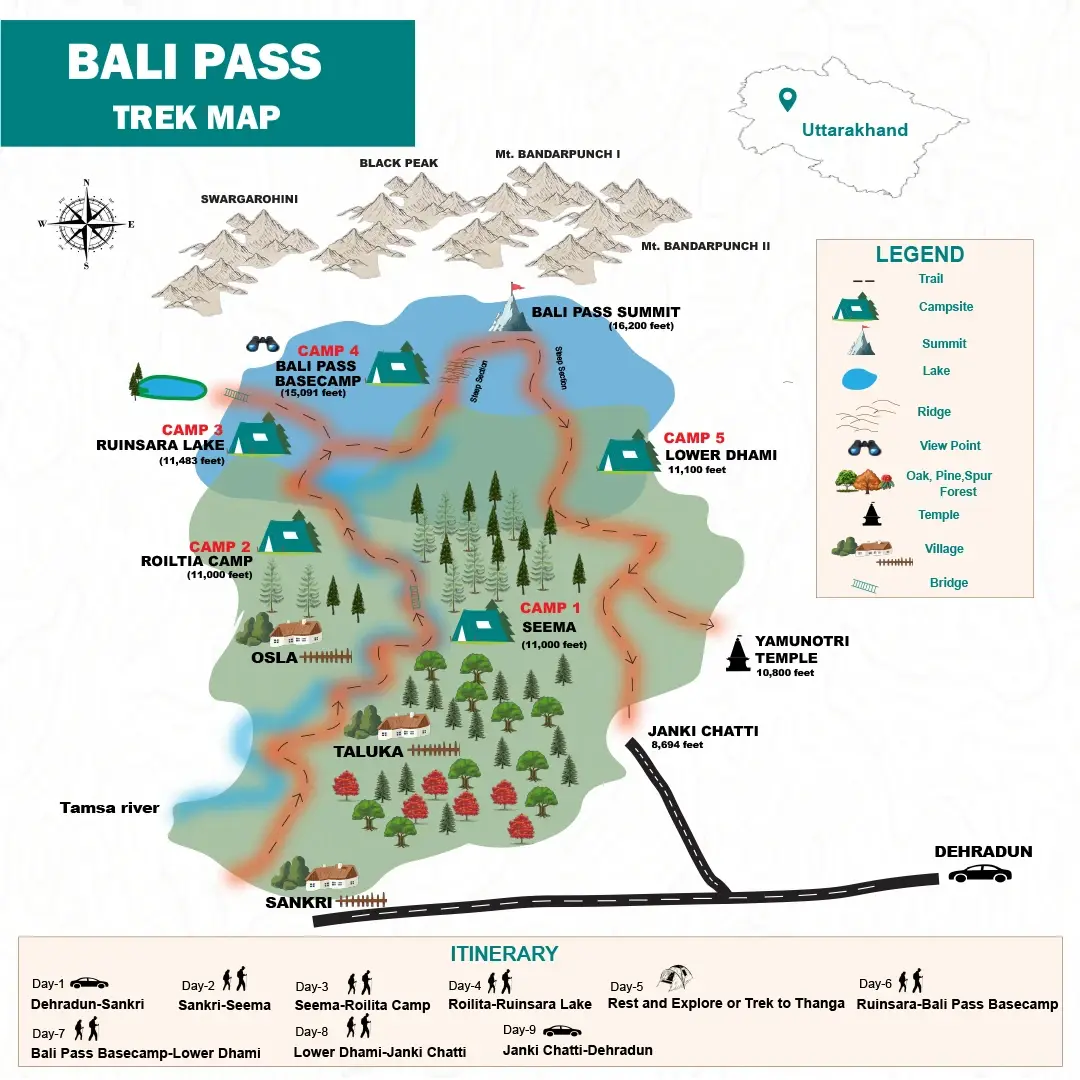
Bali Pass Trek Route Map
1. Exploration of the Govind Wildlife Sanctuary and National Park
- Flora: Deodar cedar, Chir pine, Oak, and conifers like Spruce, Blue pine, and Silver fir.
- Fauna: Himalayan snow leopard, Himalayan black bear, Brown bear, Monal pheasant, Bearded vulture, Golden eagle, Western tragopan, Steppe eagle, and Black eagle.
2. High altitude and challenging terrain
At a stunning height of 16,240 feet (4,950 meters), this walk You will travel quite a distance in the early stages of trekking to the Bali Pass on generally moderate slopes until the Ruinsara Lake. 1012 kilometers on an average day. The altitude will next rise until the base camp, when the elevation will be roughly 3,000 feet in one day followed by an additional 1,000 feet the following day.
From Bali Pass to Yamunotri is steep; the altitude drops around 8,000 feet in only two days.
3. Village Exploration
Exploring the village of the Har Ki Dun Valley (Datmir, Gangad, Puani, and Osla) and the Yamunotri Valley (Kharsali, Hanumanchatti, and Jankichatti). iscover local customs and agricultural techniques of both valleys and see many different building styles.

4. Thanga and Devsu Thatch/Meadow-
An alpine pasture 1 km from Ruinsar Lake, Thanga Bugyal is an area. It has a beautiful view of Kyarkoti Bugyal and a 2 km ridge walk with white rhododendron blooms along the way.
Devsu Thatch is a huge grassland along the way from Puani Garat to the Waterfall on the Supin River, & it is at 10,032 feet high. Day 3 was surrounded by heavy trees. There are well-kept grass mounds. And a variety of flowers, such as orchids, poppies, anemones, primulas, daisies, and marigolds. it offers a stunning experience. Barefoot walks on lush grass turn into a sensory dance with nature, motivating a day of camping to appreciate beauty.
5. Camping at the pristine lake Ruinsara
Standing at 11,483 feet (3,500 meters), Ruinsara Lake is a crucial point on the Bali Pass path, showcasing the beauty of Govind National Park with brilliant flora- particularly orchids. Along the Tons River through quaint communities like Gangad, Seema, and Osla, the trail winds. A day at Ruinsara Lake lets visitors explore close to the Black Peak base camp and Banderpoonch glacier.
6. Kyarkoti Glacier
This is the base camp for the Kalanag, Swargarohini, and Dumdar Kandi Pass trek, located around 8 kilometers from Ruinsara Bugyal. Starting for the Tons River, which comes from the Kyarkoti Glacier, it is at an altitude of 12,795 feet (3,900 meters) above sea level.
7. Waterfalls along the trail
The beauty of the 66 km Bali Pass trail is enhanced by the many waterfalls you meet. Particularly, the third day's trip across Seema and Swarn Dhara includes some stunning waterfalls that very much improve the magic of the entire hike.
8. Yamunotri Dham
Coming down from Lower Dhamini to Yamunotri, you will locate the holy Yamunotri temple, one of the Chota Char Dham in Uttarakhand. It is a particularly great location for trekkers as well as pilgrimsas it is found in the center of the Himalayas. For everyone who comes here, the tranquil surroundings offer a peaceful refuge; respect and calmness fill the air.
8. Saptrishi kund
Towards the end of the Bali Pass walk, the magnificent Bandarpunch Glacier and Saptrishi Kund materialize as the actual origin of the Yamuna River.
Located at 4,421 meters, Saptrishi Kund is a high-altitude lake and the main source of the Yamuna. Formed by the commanding Bandarpunch Mountain, this lake is surrounded by rock glaciers, adding to the magnificence of the terrain.
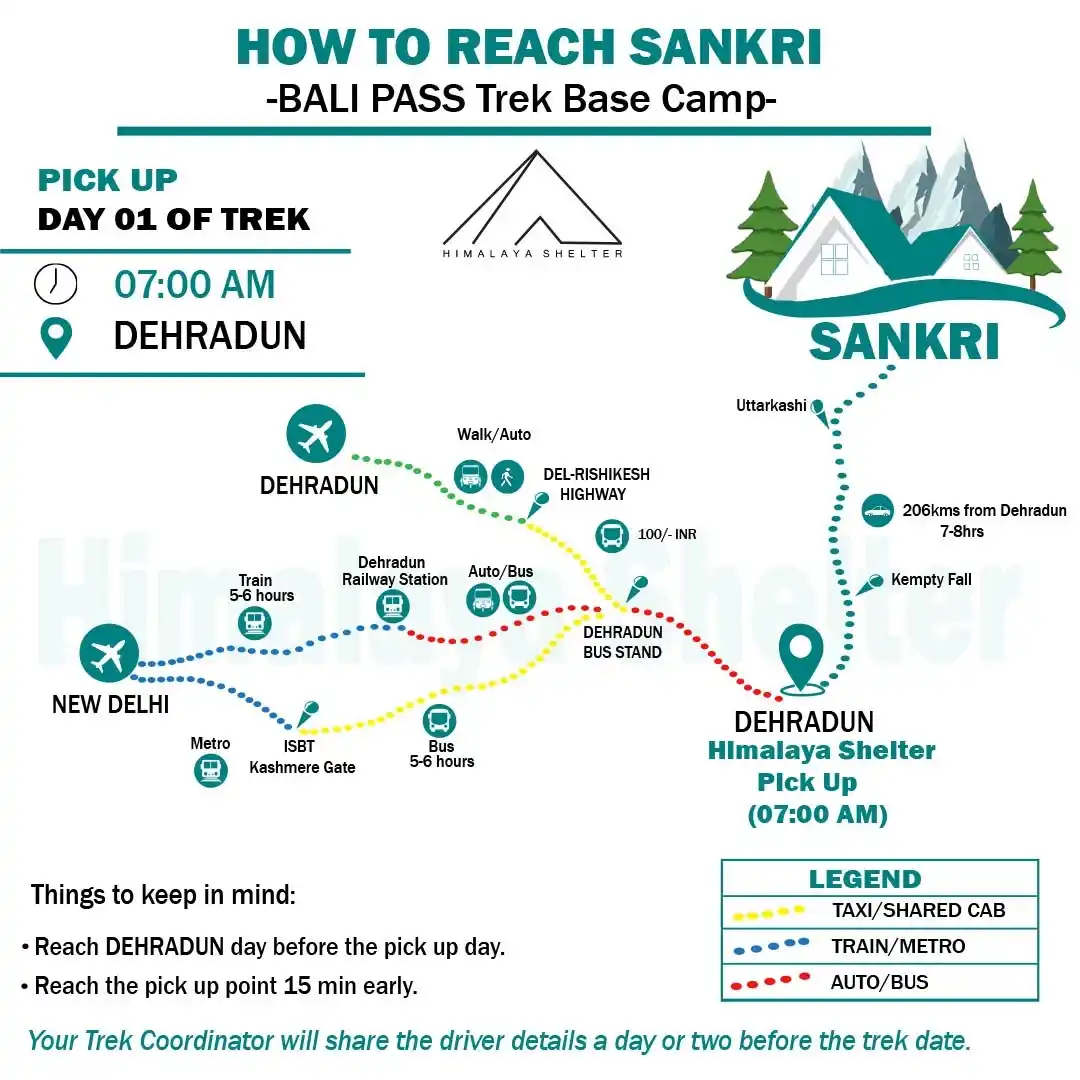
How to reach Sankri, basecamp of Bali Pass Trek
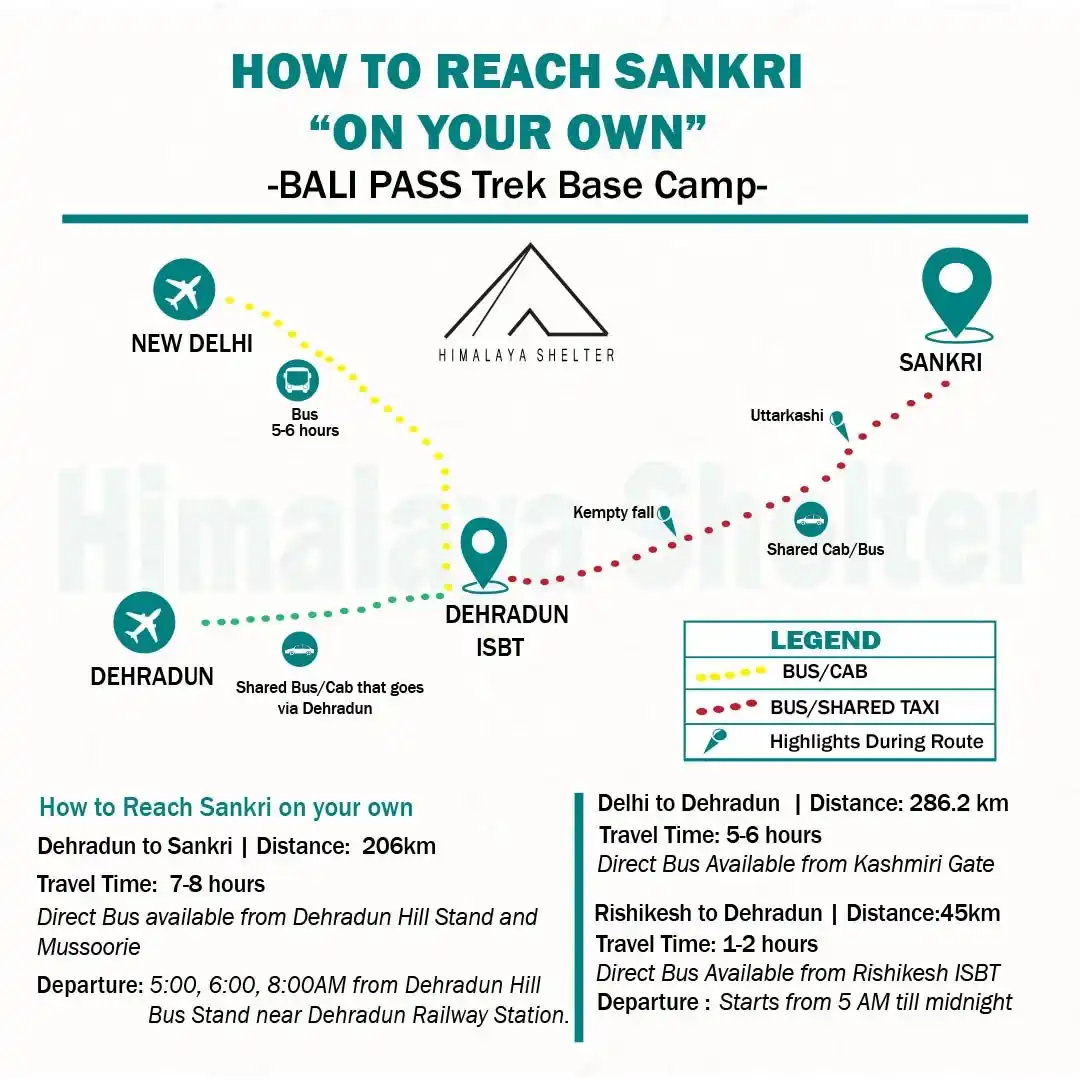
How to reach Sankri, basecamp of Bali Pass Trek"On Your Own"

How to reach Dehradun by Train
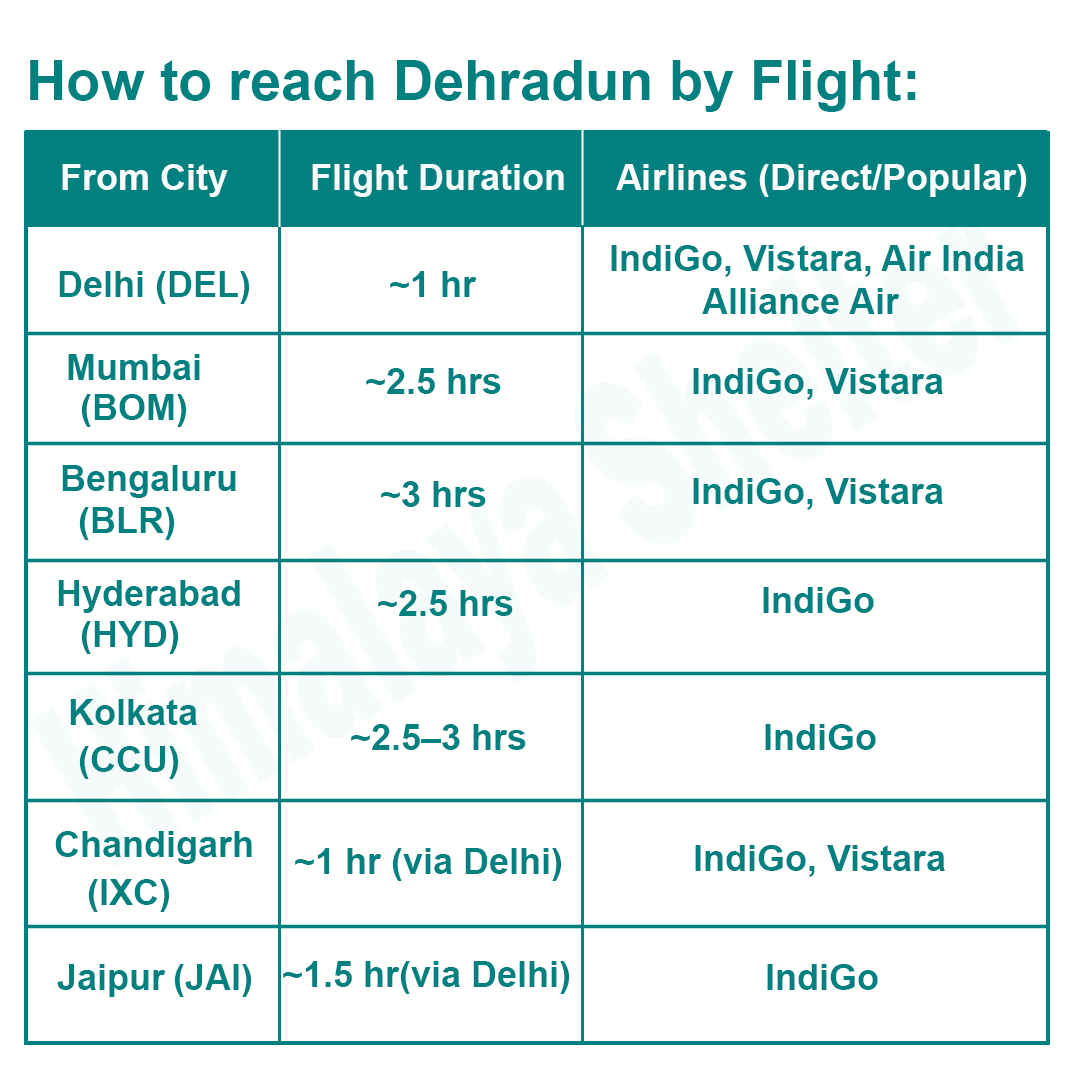
How to reach Dehradun by Flight
To Reach the Bali Pass Trek
1. How to Reach Dehradun from Delhi:–
- By Road:- Overnight UKRTC buses and Volvos, ranging from Rs 600 to Rs 900, operate from ISBT Delhi to ISBT Dehradun
- By Train:- It’s recommended to opt for the overnight Kota Express, also known as Nanda Devi/Kota Express, departing at 11:50 PM, and arriving in Dehradun at 5:45 AM, aligning with our morning pickup schedule.
- By Air:- IndiGo and Vistara , are some regular flights from Indira Gandhi Airport, Delhi to Jolly Grant Airport, Dehradun. The schedules for these flights can be easily checked online.
The Dehradun railway station, a hub for private and shared cabs heading to Sankri, is situated 30 km from the airport. Private taxis are easily accessible within the airport premises, with booking charges of Rs 1200 - 1500 for a Dzire or similar and Rs 1800 – 2200 for an Innova or similar vehicles.

2. How to Reach Sankri from Dehradun:-
Every morning, a limited number of shared cabs and buses depart for Sankri from the vicinity of Dehradun Railway Station.
- Govt. Buses and Private Buses- Only one government bus departs from Dehradun Railway Station to Sankri at 8:00 am. Additionally, two private buses leave around 7:00 am from just outside the Dehradun Railway Station heading to Sankri town. The fare for this journey is approximately Rs. 400-500 per person, which is roughly the same for both the government and private buses.
- Private Cab or Taxies- You can easily locate shared taxis near Hotel Milan or Hotel Grand, merely a 2-3 minute walk from Dehradun Railway Station. These taxis operate up to Purola, which is 54 kilometers away from Sankri. The journey lasts approximately 5 to 6 hours, with a fare of Rs. 400-500. Take shared cabs from Purola to Sankri in the morning before noon. Fare is 200-300 rupees per passenger when the cab is full. Plan your arrival in Purola accordingly.
If you miss Dehradun buses or taxis, opt for a private taxi near Prince Chowk, around 100 meters from the Railway Station. Expect to pay Rs. 6,000 to 7,000 for a Maxx or Bolero booking.
3. Getting back from Janki Chatti (Yamunotri) to Delhi:-
The trek concludes at Janki Chatti, and then you'll travel by car/bus to Dehradun, which takes about 8-9 hours. There's a single government bus departing from Jankichatti to Dehradun at 6:00 am. In case you miss the bus, you can choose a local taxi to Barkot. From Barkot, another taxi or the government bus departing at 11:00 am can take you to Dehradun, with a fare of approximately Rs. 300-350 per person.
For a more comfortable journey, You can order a separate cab for Rs. 5000–6000 each cab to make your trip more comfortable. This will take you from Janki Chatti to Dehradun. You should be there around 8:00 p.m.
If your next destination is Delhi, you can return by either the Mussoorie Express (departing at 9:20 pm) or the Nanda Devi Express (departing at 11:30 pm) from Dehradun.
The best times to do the Bali pass trekking are before and after the monsoon season, which happens in the summer and fall. Depending on how much snow fell the winter before, summer starts around the middle of May and lasts until the end of June, when the monsoon starts.
After that, the beautiful season of autumn begins in September and lasts until the end of October. These exact times not only guarantee good weather, but they also give trekkers a beautiful view of nature with bright colours and a variety of sceneries.
1. Bali Pass in May and June (Pre - Monsoon)
- Flora: In summer, the forests and meadows transform into vibrant shades of green, adorned with blossoming flowers, creating a picturesque and refreshing landscape.
- Snow condition- As summer progresses, the accumulated snow and glaciers melt, revealing a vast expanse of icy snow.
- Weather & Temperature- The daytime warms up to 10°C to 20°C in Bali Pass Trek 2025, especially in sunny conditions. At night or early morning, the base temperatures range from 5°C to 10°C.
2. Bali Pass in September and October (Autumn)
- Flora- In September and October, the scenery changes with colorful autumn leaves. Trees and grasses paint the surroundings in yellow, orange, and brown, offering a delightful sight.
Snow- In September, there is less snow, and by October, the likelihood of fresh snowfall increases. - Weather & Temperature- As you advance toward the Ruinsara Lake campsite and beyond, the weather significantly becomes colder. Daytime temperatures range from 5°C to 15°C in September and during nights or early mornings, temperatures range from 2°C to 8°C. In October, temperatures decrease noticeably, ranging from 5°C to 10°C. Be prepared for temperatures in the higher camps to drop below 0°C at night.
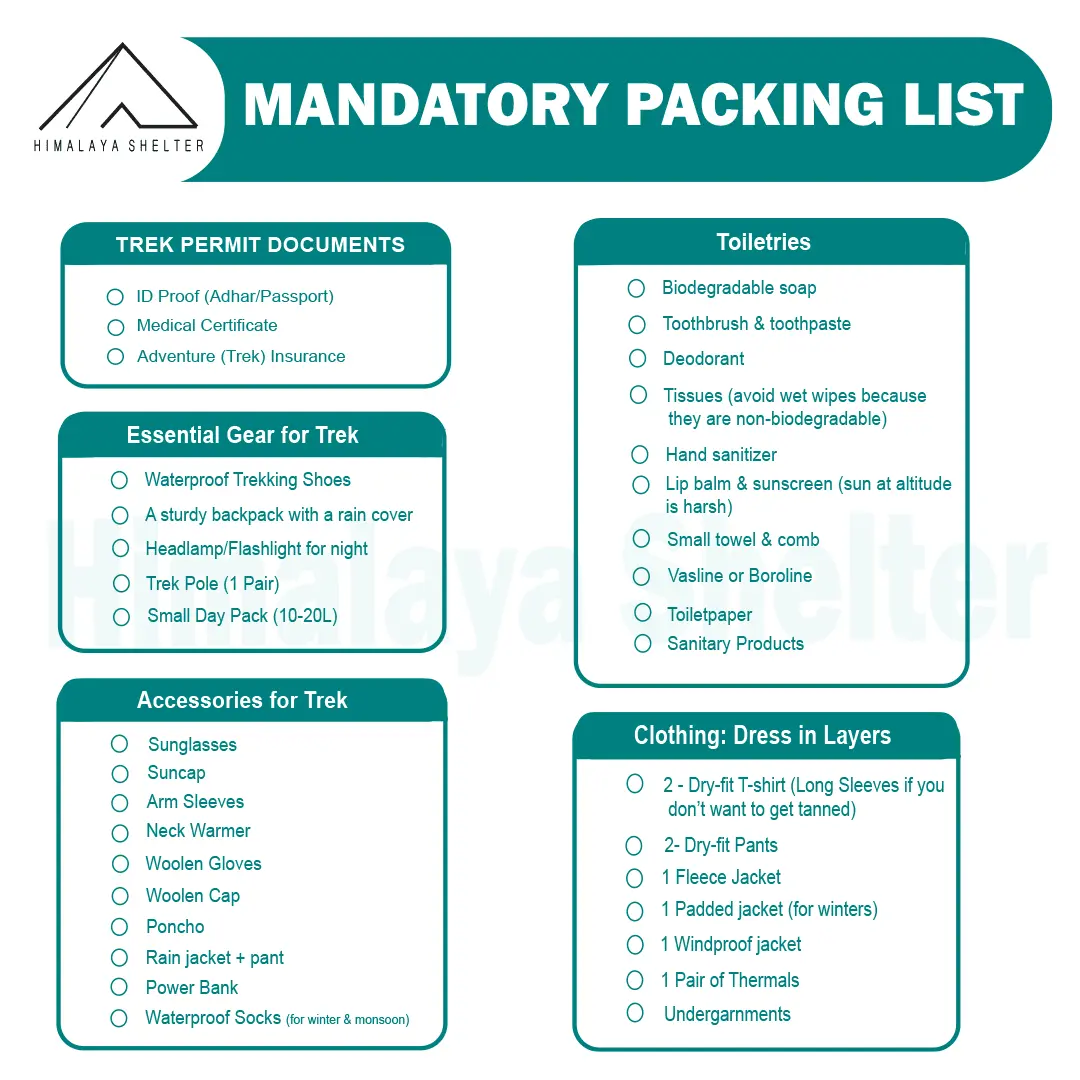
Mandatory Backpacking List for Bali Pass Trekking
If you’re physically fit and aware of the safety precautions for the Bali pass, you’ll experience the beauty of this trek 200% more effectively compared to those with weaker physical fitness and insufficient knowledge of safety precautions. This preparation enables you to fully enjoy the majestic landscapes and challenging trails without being held back by fatigue or physical limitations.
Physical Fitness Preparation for Trek:
To overcome the difficulty level of Bali pass trekking, it requires strong cardiovascular endurance, muscular strength, and overall physical fitness. Incorporate these exercises into your routine to increase strength, stability, and stamina, which will help you tackle difficult terrain sections of the trail at high altitudes.
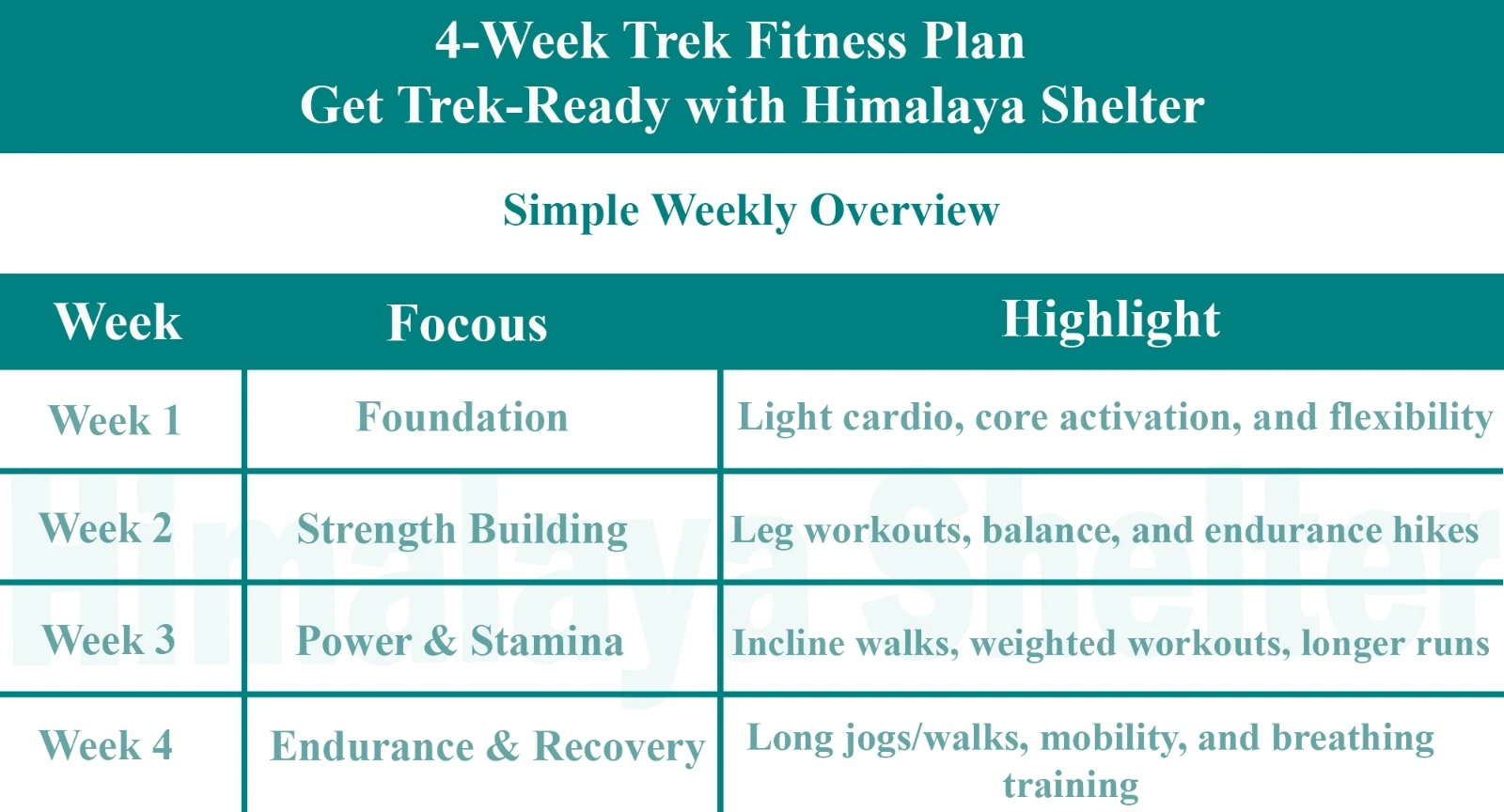
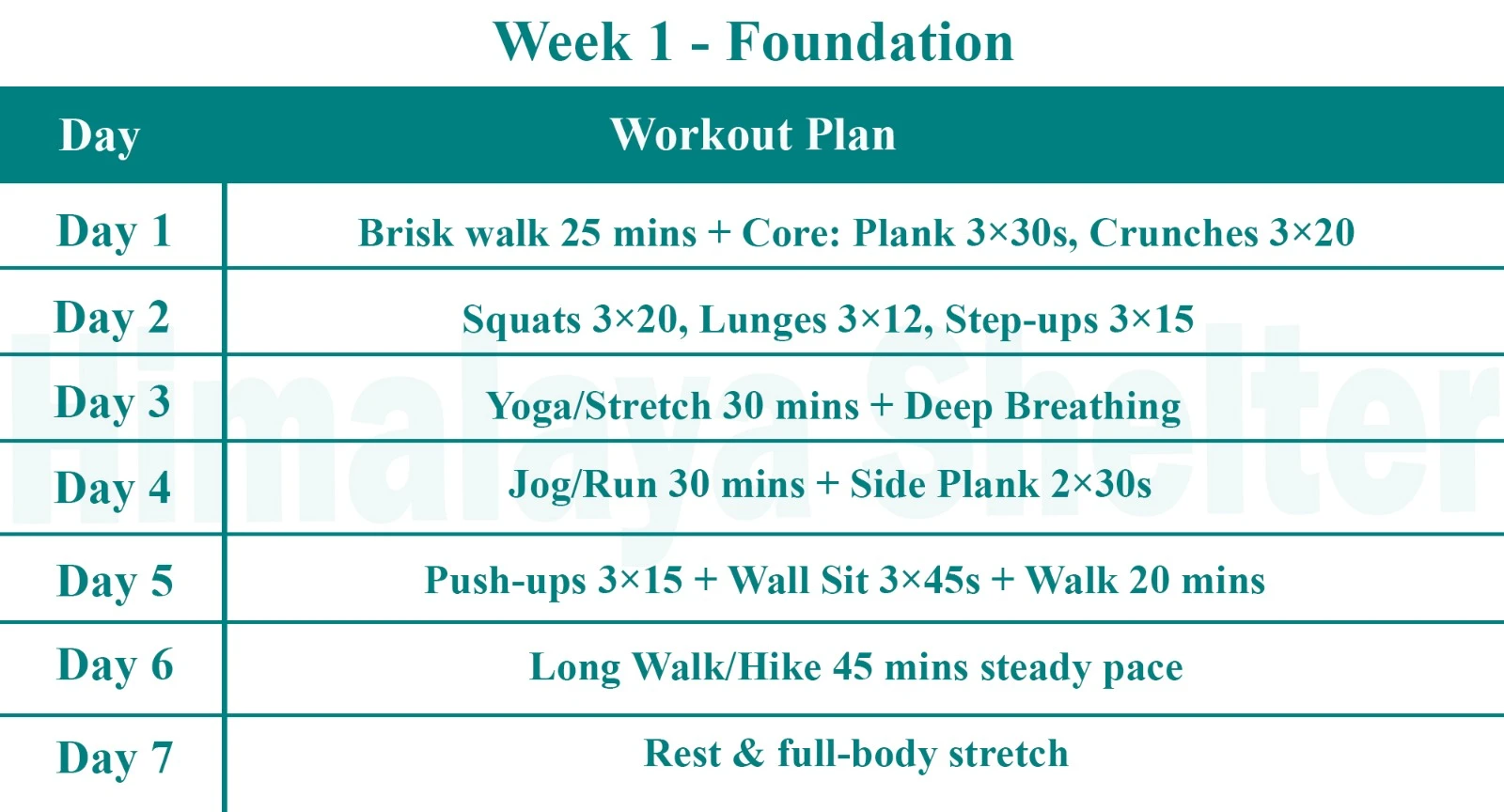
Foundation
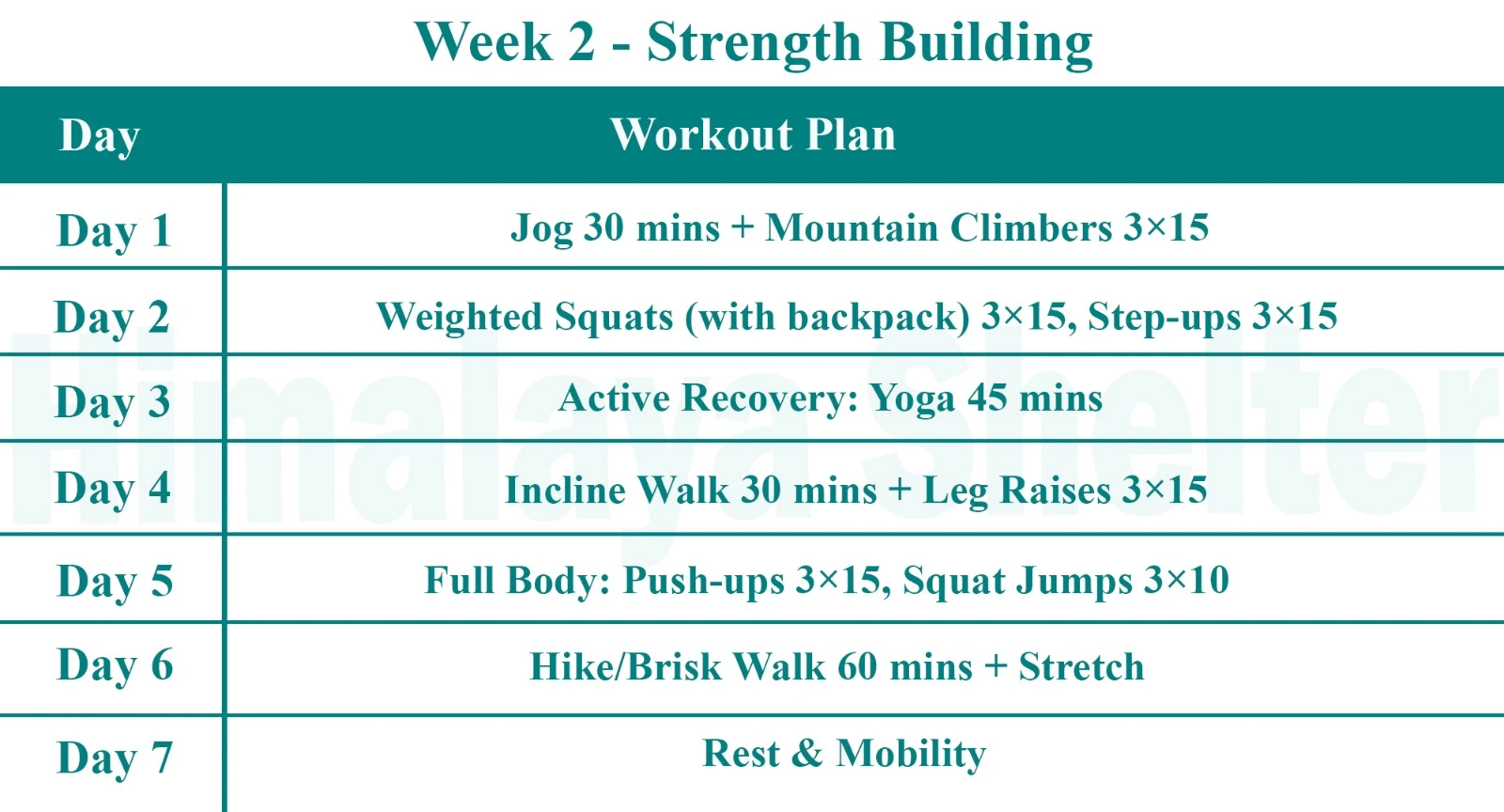
Strength Building
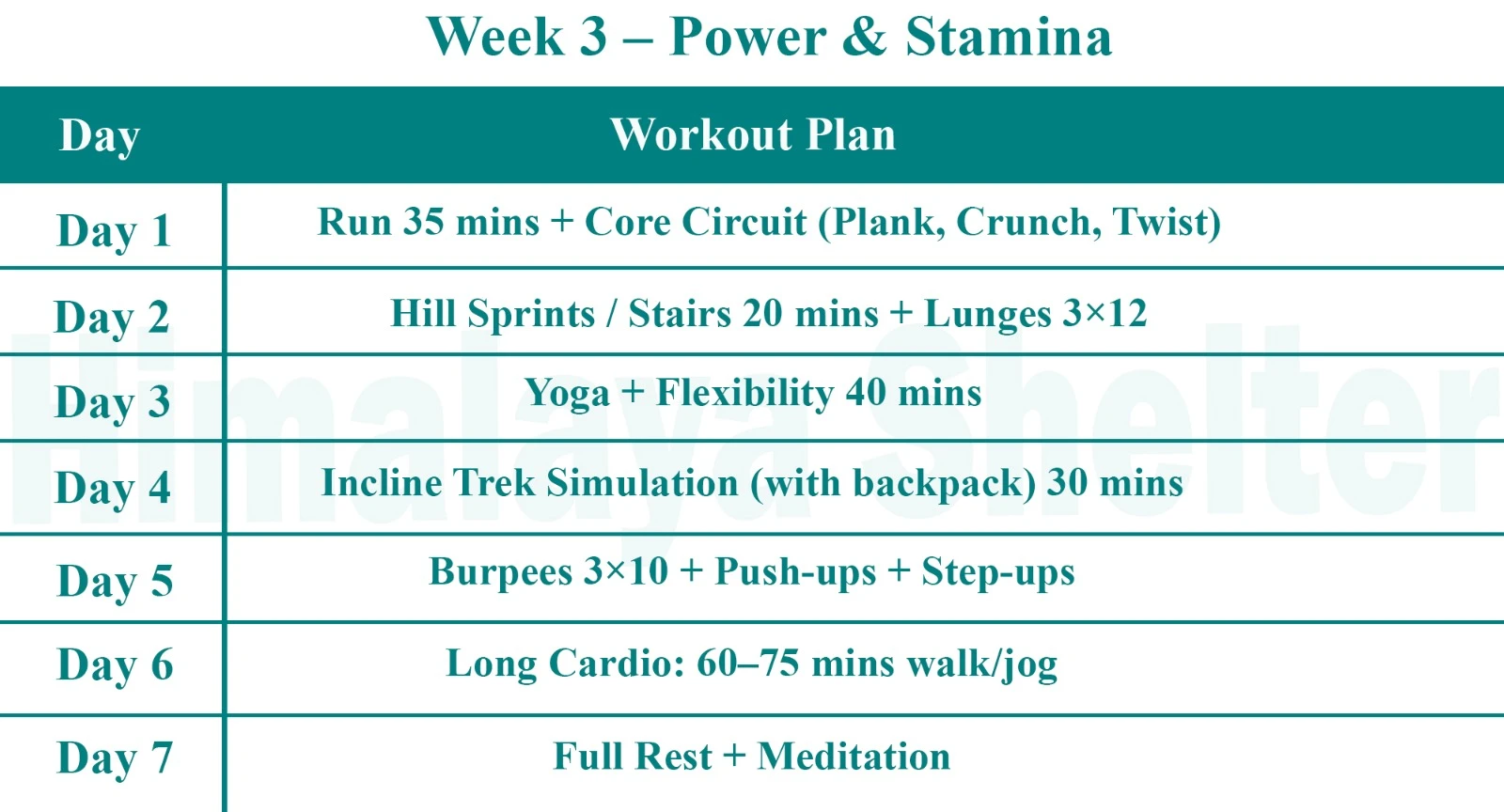
Power and Stamina
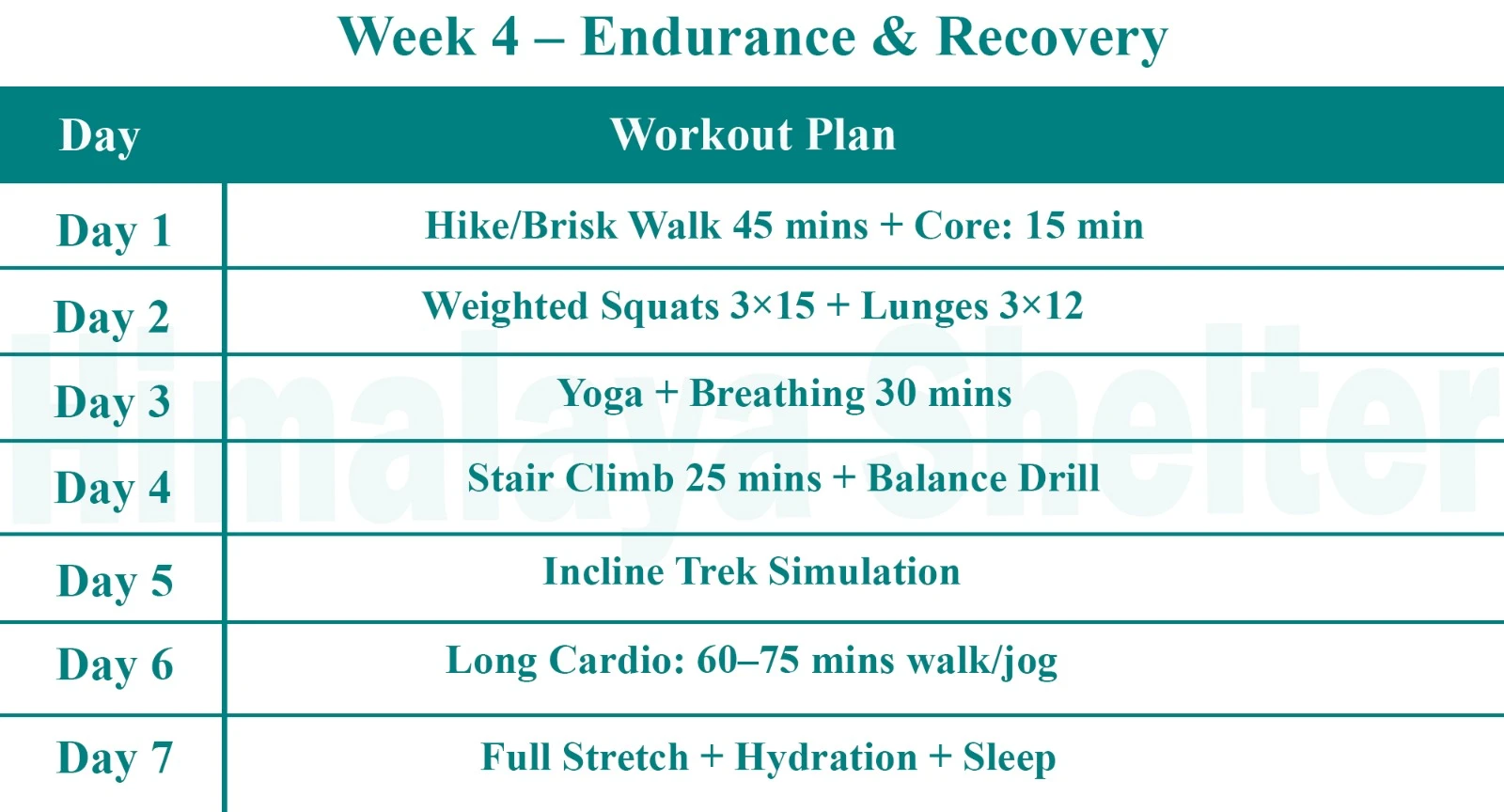
Endurance and Recovery
Additional Tips:
- Consistency & Form: Maintain proper technique and gradually increase intensity.
- Recovery & Flexibility: Allow muscle recovery, and stretch before and after workouts.
- Balance Training: Incorporate strength exercises like deadlifts for overall balance and endurance.
Regularly performing these exercises will build the necessary strength and stamina for a successful trekking experience. Good fitness is crucial for tackling the challenges of the Bali pass summit and fully appreciating the adventure it offers.
-
Acclimatization:
- Importance: Acclimatization helps stabilize oxygen levels in the body. It is crucial for preventing altitude sickness and maintaining physical fitness.
- Protocol:
- Spend an extra day at the Bali pass base camp or intermediate points to adjust to the altitude (if required).
-
Ascend gradually, avoid ascending too quickly.
-
Climb high and sleep low. After reaching the campsite, hike to a higher elevation than the campsite's altitude, spend some time there, and then return to the campsite.
-
Reduce strength exercises and increase yoga practice with Pranayama or other slow breathing techniques.
-
Weather Preparedness:
- Importance: The weather during the Bali pass can be unpredictable, with sudden rainfall and variation in temperature. Knowing weather facts helps trekkers determine the best time to start or not start their trek, and be prepared for any expected weather fluctuations during the hiking.
- Protocol:
-
Check weather forecasts regularly.
-
Be prepared for sudden changes by carrying appropriate gear, such as waterproof jackets or a poncho, warm fleece, and extra pairs of quick-dry socks.
-
In the mountains, afternoon rain is more common than other times of the day. So, make sure to start and end your hike before noon.
-
If it’s raining continuously, pause on the hike on the spot but avoid stopping near water streams and narrow valleys. Try to pass away these areas as quickly as possible.
-
-
Hydration and Nutrition:
- Importance: Staying hydrated and well-nourished helps maintain energy and health
- Protocol:
-
Drink plenty of water at regular intervals throughout the trek.
-
Carry high-energy, easy-to-digest foods like nuts, energy bars, and fruits.
-
Avoid taking alcohol.
-
Avoid consuming sugary foods or drinks during the trek. Excess sugar increases blood glucose concentration, leading to fatigue.
-
-
Health and First Aid:
- Importance: Immediate response to health issues can prevent serious complications.
- Protocol:
-
Carry a comprehensive first aid kit, including altitude sickness medication, and be familiar with basic first aid procedures.
-
Inform your trek leader of any pre-existing health conditions.
-
-
Safety Gear:
- Importance: The right gear can prevent injuries and keep you safe in adverse conditions.
- Protocol:
-
Wear sturdy, broken-in trekking boots with good ankle support.
-
Dress in layers to manage your body temperature.
-
Carry a reliable backpack with a rain cover and other essentials such as a headlamp, rope, oxygen cylinder, gaiters, and microspikes.
-
-
Emergency Preparedness:
- Importance: Quick action is vital in emergencies
- Protocol:
-
The nearest hospital is located in Dewal Block, which is nearly 28 km from the Bali pass base camp.
-
Keep emergency contact numbers.
-
Ensure that your trek leader has communication devices such as a satellite phone or walkie-talkie in case of an emergency. Also, whenever you get a mobile network, keep updated the basecamp or your emergency contact person.
-
Make sure you have appropriate adventure insurance that covers trekking in high-altitude areas.
-
-
Navigation and Trail Safety:
- Importance:Navigating high altitudes and challenging trails requires caution and skill.
- Protocol:
-
Follow your guide.
-
Follow marked trails and use a compass, maps, or GPS devices to avoid getting lost on the trail.
-
Pay attention to trail markers and avoid venturing off the path.
-
-
Wildlife Awareness:
- Importance: Encounters with wildlife can be a risk
- Protocol:
-
Maintain a safe distance from animals.
-
Avoid leaving food unattended and keep your campsite clean to avoid attracting wildlife.
-
-
Group Coordination:
- Importance: Staying connected with your group ensures collective safety
- Protocol:
-
Maintain regular communication with your group.
-
Follow the trek leader’s instructions and avoid separating from the group.
-
-
Environmental Responsibility:
- Importance: Protecting the natural environment is essential.
- Protocol:
-
Follow "Leave No Trace" principles.
-
Dispose of waste properly and avoid disturbing wildlife or vegetation.
-
-
Altitude Sickness Awareness:
- Symptoms: Headache, nausea, dizziness, and shortness of breath.
- Protocol:
-
If symptoms occur, inform your trek leader immediately.
-
Descend to a lower altitude if necessary and seek medical help if symptoms persist.
-
On the Bali pass trekking, there are less chances of altitude related sicknessess. Also, you ascent gradually each day of hiking which helps you to be fully acclimitazation. Still, if any symtoms occurs, keep your walking pace slow and steady untill you reach back to the basecamp or a lower altitude campsite.
-
-
Up Close with Kalanag and Swargarohini Peaks
Bali Pass has a lot to offer apart from its virgin trails and a challenging pass climb. We are surrounded either by the mighty Swargarohini or Bandarpunch ranges at almost all times.
We get to see Kalanag (Black Peak) & Swargarohini Peak up close. At 6,387 meters, the Kalanag peak is the highest in this region. This peak was first summited by Jack Gibson in 1955 and the students of Doon School. We spent a day beside Ruinsara Lake. The walk across the two meadows of Devsu Thatch and Thanga is breathtaking. One of our camps will be beside a waterfall and another one lies above 4,000 m.
-
Wild Encounters and Summit-like Adventures
Wild animals such as Himalayan Ibex and Blue Sheep, Black Bears, and Brown bears can be spotted occasionally on this trail! Our teams sighted the Black bear on this trail ahead of Seema and near the waterfall camp, while the Brown bear was spotted near Thanga Campsite, and during an exploration towards Dhumdhar Kandi pass during the rest day at Ruinsara Lake. While the trail to Bali passes turns southward towards Yamunotri ahead of Ruinsara Lake, the eastward route continues to the challenging Dhumdhar Kandi. It's a daunting pass sharing its base camp with Black Peak and goes to Harsil.
The Bali Pass unlike a conventional pass, which means a saddle-like opening between neighboring rising ridges, rises like a peak and gives a summit-like adventure when you reach the top. The same can be visually seen in the summit stretch picture of the Bali pass below.
Towards the end of the Bali Pass trekking, we see the Bandarpunch Glacier & Saptrishi Kund. They are the true source of the river Yamuna. We also get an opportunity to visit the holy temple of Yamunotri. All in all, Bali Pass is a wholesome adventure that provides trekkers with every element of a Himalayan trek.

Day 1: Drive from Dehradun to Sankri | Drive: 190 km; 8 hrs
Our journey begins from Dehradun, making it a good option for people looking for treks near Delhi. Driving alongside the Tons river, and passing villages in Uttarakhand like Damta, Purola, Mori, and Netwar, we will reach the base camp Sankri. There is no network in this village, letting us take in the sight of the sun gloriously setting over the surrounding Greater Himalayan peaks without any distractions. We will be accommodated in hotels or homestays here.

Day 2: Trek from Sankri (1,920 m) to Seema (2,560 m) via Taluka (2,050 m) | Drive: 1 hr; Trek: 14 km; 5-6 hrs
After a hearty breakfast, we will be transported to Taluka by car. The motorable road in Govind Pashu National Park ends here. The trek commences on a stony path alongside the gushing river Supin. We also see plantations of the red-coloured Himalayan crop amaranth, locally known as cholai. Under the shade of walnut, pine, deodar and maple trees, the walk is as pleasant as the villagers greeting us on the way.
A few hours and crossing over a few streams later, we see the village of Gangad across the river on the left. We continue our hike and after about an hour, the quaint village of Osla unfolds itself. Osla is a household name among trekkers. Home to about 200 families, it gives us a peek into Garwahli culture. Seema is a tiny settlement opposite to Osla on the other side of the river. We set camp here or stay in a hut with a local family in the village.

Day 3: Trek from Seema (2,560 m) to Roiltia or Waterfall camp (3,350 m) | Trek 13 km; 6 hrs
Leaving the last of human settlements behind, we continue along the true left of the valley along the river Supin. Supin merges with Rupin near Netwar village to form Tons, which is the biggest tributary of river Yamuna.
An ascend through deodar trees leads us to a beautiful meadow – Devsu Thatch. This 1km expanse of green land is set against the looming Swargarohini ranges. We can also see Kalanag (Black Peak) (6387m) straight ahead. On our left, we can see Har Ki Dun Valley. At its bottom lies the confluence of Har Ki Dun and Ruinsara rivers.
After descending from the meadow, we enter the Ruinsara valley. At the end of today’s trek, we camp beside the stream close to the waterfall locally known as Roiltigad or Roiltia.

Day 4: Waterfall to Ruinsara lake (3,600 m) | Trek: 4 km; 2 hrs
Today’s journey is going to take in under 2 hours even at a slow pace. And within this hike itself we notice a stark change in vegetation. Pine and fir trees give way to birch and rhododendron trees. The thick forest we trudge through is frequented by the endangered Himalayan brown bear. If we are very lucky, we might spot this rare and elusive creature.
We then reach one of the highlights of the trek — Ruinsara Tal, an alpine tarn, surrounded by lush Rhododendron trees, with their distinct pink bloom in the summers. We will be left enchanted by this sacred lake in the Uttarakhand Himalayas. It is one of the trio of lakes in the Garhwal region, the other two lakes being Marinda and Maldaru. We will be camping overnight near the lake.

Day 5: Ruinsara lake - rest and explore or Trek to Thanga | Trek: 3 km; 1.5 hrs
Lying at an elevation of about 3500 m, Ruinsara lake is a good place to acclimatize ourselves before reaching Bali Pass base camp the next day.
Ruinsara Tal’s reputation precedes itself for its beauty. The small and pristine lake lies within a vast meadow, alpine vegetation and surrounding rhododendron bushes. There is innumerable variety of alpine flowers growing around the lake. The river Supin is situated 100 meters below the lake, next to a ridge.
It is the perfect place to play games with our trek mates, read a good book or just sit quietly to soak in nature’s tranquillity.
We can also spend the day exploring nearby places. One can trek towards the Banderpunch glacier or Kyarkoti which is the base camp for Kalanag and Dumdar Kandi pass.
We return to the camp in the evening.

Day 6: Ruinsara lake/Thanga to Bali Pass Basecamp (4,600 m) | Trek: 8 km; 7 hrs
We start the day early so as to reach our destination before afternoon. We descend down to the shallow river bed, cross over to the opposite bank and walk uphill to another beautiful meadow – Thanga. This meadow also offers awe-inspiring views of the seemingly omnipresent Swargarohini ranges. Kyarkoti valley lies towards the left.
We soon reach Odari. The word ‘Odari’ means a naturally made cave rock. This place has a mythological story associated with it. It is believed that Bali, Hanuman’s brother, had stayed here for one night. Here too we might find evidence of the rare Himalayan brown bear. We camp below Bali Pass along a glacial moraine. This is the one of the best locations for a camp, with the valley below and the Pass behind us. The temperatures at night tend to go to sub-zero degrees. Camping at this altitude is a unique experience which very few treks offer.

Day 7: Bali Pass Basecamp (4,600 m) to Lower Dhamni (3,200 m) via Bali pass (4,900 m) | Trek: 12 km; 9 hrs
This day of crossing Bali Pass too begins very early. We strive to reach the summit by 8am. The trail heads down south, over a ridge. It is a fairly short but steep climb up to the Pass. A lot of glacial scree will be encountered here. Time taken to reach the top ranges from 45 minutes to one and a half hours.
Once we reach the top, we behold the Yamunotri valley for the first time. The view is breath- taking. We see hints of the Saptrishi Kund, which is the origin of river Yamuna. We also get to witness the Banderpunch peaks from the top of the Pass. The summits of Dayara Bugyal, Barua Top and Dokrani Bamak are visible too. We then descend carefully via a connecting ridge and reach the camping grounds of upper Dhamni.

Day 8: Lower Dhamni to Yamunotri to Janki Chatti (2,400 m)| Trek: 12 km; 6 hrs
We descend further to a forested trail. This path leads us to the famous shrine of Yamunotri with the glorious Bandarpunch in its background. One of the temples in the Char Dham circuit, it is dedicated to Goddess Yamuna. After paying obeisance to her black marble idol, we make our way down the conventional pilgrim road to Janki Chatti. We stay overnight in one of the guesthouses here. We will get electricity but no phone network.

Day 9: Drive from Janki Chatti to Dehradun | Drive: 190 km; 8 hrs
This is the final day of the trip and we drive back to Dehradun. We can make the most of this jourey by visiting other well-known places that fall on this route such as Kempty waterfalls, Nainbagh and Mussourie.
With equally beautiful memories of an offbeat trek and touristy sight-seeing, we have a cherishable experience.

Our treks are specially designed by the experienced team at Himalaya Shelter, taking you on an adventure of a lifetime all while making you connect not only with the bountiful nature but also with yourself and with others on the trek with you creating wonderful memories which will last you a lifetime. All Himalaya Shelter treks are guided by experienced Trekkers having vast knowledge and experience of the region, providing with insightful information and stories pertaining to the region’s flora and fauna and the history of the region whilst the trek. It is safe to say that on successfully completing the trek, one will gain tremendous insight and experience along with lifetime memories.
Trek Inclusions
- Transportation – Day 1: Driver from Dehradun to Sankri. Pickup time: 7:30 am, Prince Chowk, near Dehradun Railway Station
- Accommodation – At Base Camp, stay at a local homestay or guest house for one night each, which will give you an insight into the authentic lifestyle of the locals.
- On Trek stay in a 2-person Vango Halo Pro/A-Shape tent, which is to be shared by two trekkers, built to withstand extreme weather conditions and at the same time making you comfortable after a hard day’s trek.
- Camping Equipment – specially designed sleeping bags that can withstand harsh weather conditions, foam mattresses. Other safety gear like microspikes, gaiters, an ice axe, and helmets will be provided.
- Medical Kit – our team will be equipped with an extensive medical kit, which our team is trained and experienced to use. Oxygen cylinders are used after they are thoroughly inspected throughout the Trek. Even campsites have large oxygen cylinders as backups.
- Permission - Forest entry charges for Indian nationals (Additional charges will be applicable for international tourists)
- Meals – Breakfast, packed lunch (on trek days), evening snacks, and dinner will be served. A hearty, delicious, and nutrition-filled Veg meals with egg preparation will be provided throughout the trek. (Jain and Vegan Food can also be arranged on prior notification.)There will be a dedicated Kitchen Tent along with a dining tent, which will have a dining table too.
- Our Team – A highly experienced and AMC-certified Trek Leader who will help ensure that the entire trek goes smoothly and safely while navigating the challenging conditions during the trek, and is skilled enough to navigate any medical emergency that can arise during the trek. Local and route Guides who are well-versed with the region and provide an in-depth insight into the local customs and knowledge of the flora and fauna endemic to the region. A dedicated Kitchen staff, which includes a Cook, a helper, and other support staff. There will also be porters and mules to carry common equipment.
- CLOAKROOM - We have a cloakroom facility available for extra luggage. Every trekker is permitted to leave their luggage behind at no charge.
Exclusions
- Personal expenses like tips, personal medicines, phone calls etc.
- Travel Expenses - Travel expenses from your hometown to the mentioned Pick-Up Point are not included in the trek fee.
- From the scheduled pick-up spot to the base camp, we have our own fleet of vehicles like Bolero, Innova, Dezire, or Tempo Traveler (12-seater). This is be shared by trekkers for a pre-decided amount. All vehicles are non-AC.
- Personal Equipment - Any personal gear like jackets, shoes, cutlery, or backpacks are not included in the trek fee. We recommend renting them from our Rental Store for an affordable fee. This can be pre-arranged to avoid last-minute hang-ups.
- Offloading - We encourage carrying your backpack to get into the true spirit of trekking. However, if needed, you can opt to offload your personal luggage of up to 12 kgs for an additional cost of INR 500 per bag per day.
- Trek Insurance - A mandatory trek insurance fee is charged in addition to your trek fee. Since most medical insurance doesn’t cover adventure activities, trek insurance offers essential coverage, enhancing your safety without a significant financial burden.
- Buffer day on the trek - We have kept a buffer day on the trek to account for any weather-related delay. If this is utilized, you will need to pay an extra amount to your trek leader.
- Anything apart from inclusions
- Please carry a lunch box for a packed lunch/breakfast to avoid using polythene and Aluminium foil.
Keeping the Himalayas clean is our own responsibility. Reduce the use of Plastic when you are in the abode of the Sacred Himalaya. 🌱
It is a challenging high-altitude trek with steep climbs, snow sections, and minimal technical terrain.
In May and June, summer brings nice weather with warm, sunny days on the trail. There’s plenty of sunlight, and you’ll find shaded spots for resting. Evenings might feel a bit cool, so having an extra warm layer of clothing is a good plan. Sometimes, it might rain a little in the afternoon, so be ready for that. Once you go past Odari, remember that because you’re up high, it could snow if the weather gets bad. The first three weeks of September bring a really amazing sight in the Himalayas. This short time, with not much rain or snow, shows a world of lively beauty and untouched nature. The meadows explode with lots of colors as wildflowers, excited by the rain, bloom in a spectacular way. Tall grasses sway gently, adding to the vibrant scene. The melting snow uncovers a path of rocks and sand, showing the way to the Bali Pass. As September ends and October brings a chill, the first snowflakes start to fall gently. This tells us that the pass will close soon. This quick change from warm summer to cool winter shows how nature always changes in beautiful ways
As you trek along, you’ll see really tall mountains like Black Peak (6,387 m), the big Swargarohini Massif, and the strong Bandarpunch Massif. You’ll be able to see towering peaks like Black Peak (6,387 m), the majestic Swargarohini Massif, and the imposing Bandarpunch Massif along the trek. In the heavily wooded areas between Osla and Ruinsara Lake, you may come across Black Bears. Further up, towards the Dhumdhar Kandi pass, you can find Brown Bears. Blue Sheep is another prominent species found in the area. The pass itself feels more like a summit than a low point of the trek. The last stretch to the pass offers incredible panoramic views as a reward.
The best time for the Bali Pass trekking is from early May to late June, and then again from early September to mid-October. It’s worth noting that weather conditions can be unpredictable during the monsoon season. In winter, the region is enveloped in heavy snowfall, rendering it a picturesque yet challenging terrain.
The Bali Pass presents a challenging high-altitude adventure amidst the grandeur of the Himalayas in India. Adequate preparation with the right gear and equipment is paramount.
Here’s a comprehensive list of essentials for the Bali Pass Trek:
Clothing: Trekking shoes with robust ankle support Backpack equipped with a rain cover Trekking gaiters Trekking crampons or microspikes Insulating, waterproof layers, including a down jacket Sub-zero temperature suitable sleeping bag Hat, gloves, and scarf Other
Crucial Gear: Trekking poles for stability UV-protected sunglasses and high-SPF sunscreen Water bottles and reliable purification tablets Headlamp or flashlight with spare batteries Comprehensive first aid kit with vital medications Map and compass for navigation A versatile knife or multi-tool Toiletries for personal hygiene Nutritious snacks and sustenance.
Consider the Following Additional Items: Camera to capture the breathtaking vistas Power bank for uninterrupted connectivity Engaging reading material or entertainment Effective insect repellent Cash for unforeseen expenses Packing judiciously is key, as you’ll be responsible for your own backpack throughout the trek. Dressing in layers allows adaptability to fluctuating weather conditions. Embrace the adventure, but also prioritize safety and comfort on this remarkable journey through the Himalayas.
The altitude of Bali Pass Basecamp is 4,600 meters (16,250 feet) above mean sea level.
The Bali Pass is an advanced-level expedition not recommended for beginners. It demands robust physical fitness, endurance, and a spirit of adventure. The trail traverses dense forests and steep gradients, presenting challenges that may be overwhelming for novices. For those new to trekking, it is advisable to embark on less demanding journeys in the Himalayas.
Some excellent options for beginners include Kedarkantha Trek, Har Ki Dun Trek, Chopta Chandrashila Trek, and Deoria Tal Trek.
Once you’ve gained experience trekking in the Himalayas, you can consider taking on the Bali Pass Trekking. Here are invaluable tips for novice trekkers contemplating the Bali Pass:
- Preparation is Key: Prioritize physical fitness with a regimen of regular cardio and strength training exercises to enhance endurance and strength. Gradual Acclimatization: Allow your body to adjust to higher altitudes by spending a few days at lower elevations before embarking on the trek. This crucial step minimizes the risk of altitude-related discomfort.
- Choose a Reliable Guide or Trekking Company: Opt for an experienced and reputable trekking company or guide. Their expertise ensures your safety and well-being throughout the trek, offering guidance on the best practices. Listen to Your Body: Pay close attention to your body’s signals. Take breaks when necessary and avoid pushing yourself excessively. Overexertion can lead to altitude sickness and other health concerns.
- Pack Wisely: Carry essential gear including appropriate clothing, trekking equipment, and ample provisions. Ensure your backpack is well-organized and doesn’t exceed a comfortable weight. Stay Hydrated and Nourished: Maintain a steady intake of water and energizing snacks to sustain your energy levels throughout the trek.
- Follow Leave-No-Trace Principles: Preserve the natural beauty of the trail by minimizing your environmental impact. Dispose of waste responsibly and leave nature untouched.
- Prioritize Safety: Be aware of your surroundings and adhere to safety guidelines provided by your guide. Stay on designated paths and avoid risky shortcuts.
- Embrace the Journey: Take time to appreciate the stunning landscapes, diverse flora, and fauna, and the unique cultural experiences that the trek offers.
- Emergency Preparedness: Carry a basic first-aid kit, emergency contacts, and communication devices. Familiarize yourself with emergency procedures and evacuation routes.
- Respect Local Customs and Traditions: Interact respectfully with local communities and embrace their cultural practices. By heeding these suggestions, beginners can embark on the Bali Pass with confidence, making the most of this awe-inspiring adventure in the heart of the Himalayas
Bali Pass got its name from the ancient stories of the Mahabharata and Hindu scriptures. Bali, known as the king of monkeys, ruled over Kishkindha Mountain and is celebrated as the one who defeated Ravana.
The ideal time for the Bali Pass Trekking is late May or early June. During late May or early June, the snow begins to melt, and the sun shines brightly, making the Bali Pass less challenging. The surroundings become lush with vibrant plant life, creating a beautiful scene for trekkers.
September and October are perfect for the Bali Pass trekking after the monsoon. The weather is lovely—clear skies, sunny days, and mild temperatures (10-15°C)—ideal for a comfortable trek without the summer heat.
Bali Pass is located in Garhwal Himalayas, Uttarakhand
Yes, Bali Pass trek is considered one of the most difficult and challenging treks due to steep climbs and uneven terrain.
Yes, it reaches around 4,950 meters (16,240 feet).
The Bali Pass trek is around 60 km long.
Sankri Village in Uttarkashi District is the base camp or starting point for Bali Pass.
It takes 7 to 9 days.
Yes, it connects Har Ki Dun to Yamunotri and offers you a view of Bandarpoonch
Yes, due to its difficulty level and high-altitude, it's suitable for experienced trekkers.
Bali Pass Trek Videos
Bali Pass Trek
Read More on Bali Pass Trek
Photo Gallery
















Treks by Categories
Treks By Month

Treks By Experience










